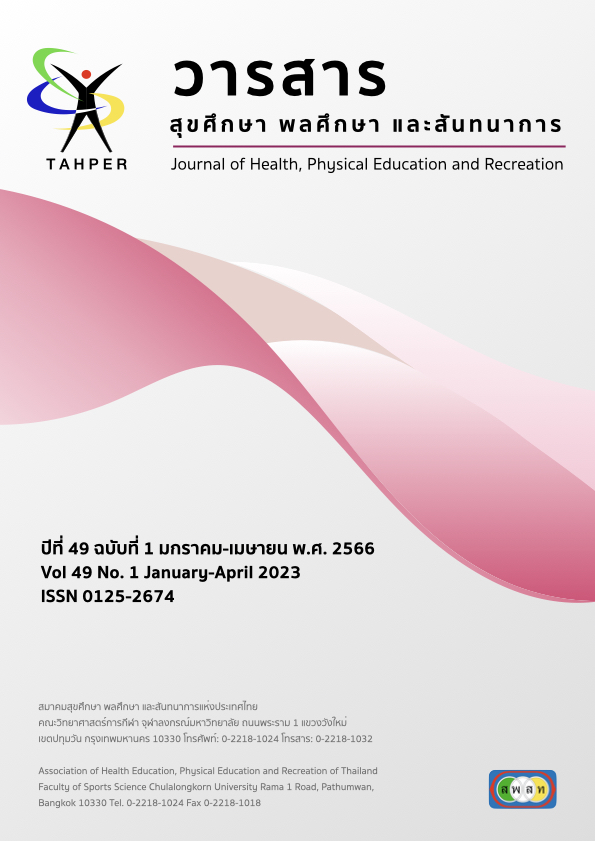Effect of Training Volume on Muscle Changes
Main Article Content
Abstract
The purpose of this research were to compare the effects of weight training volume on muscle changes using intensities at 75% of 1 RM and less than 75% of 1 RM but keeping training volume equal. The sample consisted of 30 male volunteers who were in year one physical education major, Thaksin University, Songkhla campus. They were divided into 3 groups of ten people each, consisting of a control group, experimental group 1 weight training at 75% of 1 RM, and experimental group 2 weights training at less than 75% of 1 RM. The statistics used in the study were mean, standard deviation, analysis of variance, and pair sample t-test before and after training
The results after the eight weeks of the experiment showed 1) There were an increase in muscle circumference after the training program as a result of expansion in the cross-sectional area of the muscles, 2) a significant difference in muscle mass between the control group and the two experimental weight training groups at a level of .05 However there were no significant difference in muscle mass between experimental group one and experimental group two. 3) Muscle strength in both upper and lower muscle groups were improve when compared before training for both experimental. These results showed that both weight training programs can improve both upper and lower muscle strength.
Article Details

This work is licensed under a Creative Commons Attribution-NonCommercial-NoDerivatives 4.0 International License.
Critical thinking in journals is the right of the author. The Association of Health Education, Physical Education and Recreation of Thailand is not always required, to create diversity in ideas and creativity.
ความคิด ข้อวิพากษ์ในวารสารเป้นสิทธิของผู้เขียน สมาคมสุขศึกษา พลศึกษา และสันทนาการแห่งประเทศไทยไม่จำเป็นต้องเห็นชอบด้วยเสมอไป เพื่อให้เกิดความหลากหลายในความคิดและความสร้างสรรค์
References
เจริญ กระบวนรัตน์. (2538). การปรับสภาพของกล้ามเนื้อในการฝึกความแข็งแรง. กรุงเทพฯ: คณะศึกษา มหาวิทยาลัยเกษตรศาสตร์.
เจริญ กระบวนรัตน์. (2544). การฝึกกล้ามเนื้อโดยการยกน้ำหนัก. กรุงเทพฯ: ภาควิชาพลศึกษา คณะศึกษาสาสตร์ มหาวิทยาลัยเกษตรศาสตร์.
ชูศักดิ์ เวชแพศย์ และ กันยา ปาละวิวัธน์. (2536). สรีรวิทยาการออกกำลังกาย. กรุงเทพฯ: ไทยวัฒนาพานิช.
ธีระศักดิ์ อาภาวัฒนาสกุล. (2552). หลักวิทยาศาสตร์ในการฝึกกีฬา. กรุงเทพฯ: จุฬาลงกรณ์มหาวิทยาลัย.
สบสันติ์ มหานิยม. (2555). ผลของการฝึกด้วยน้ำหนักที่มีต่อสมรรถภาพทางกายและสัดส่วนร่างกายของนิสิตมหาวิทยาลัยเกษตรศาสตร์ วิทยาเขตกำแพงแสนที่ลงทะเบียนเรียนวิชาการฝึกด้วยน้ำหนัก. นครปฐม: มหาวิทยาลัยเกษตรศาสตร์.
เอกวิทย์ แสวงผล. (2535). ผลของการฝึกยกน้ำหนักแบบวงจรที่มีต่อความคล่องแคล่วว่องไว ความแข็งแรงของกล้ามเนื้อและความอดทนของกล้ามเนื้อ (วิทยานิพนธ์ปริญญามหาบัณฑิต). กรุงเทพฯ: จุฬาลงกรณ์มหาวิทยาลัย.
Aguiar, A. F., Buzzachera, C. F., Pereira, R. M., Sanches, V. C., Januario, R. B., Da Silva, R. A., Rabelo, L.M., Oliveira Gil, A. W. (2015). A single set of exhaustive exercise before resistance training improves muscular performance in young men. Eur J Appl Physiol, 115(7), 1589-1599.
Baechle, T. R., & Earle, R. W. (2008). Essentials of strength training and conditioning (3rd ed). Champaign, IL: Human Kinetics.
Haff, G., & Triplett, N. T. (2016). Essentials of strength training and conditioning. Fourth edition. Champaign, IL: Human Kinetics.
Lasevicius, T., Ugrinowitsch, C., Schoenfeld, B. J., Roschel, H., Tavares, L. D., De Souza, E. O., Laurentino, G., Tricoli, V. (2018). Effects of different intensities of resistance training with equated volume load on muscle strength and hypertrophy. Eur J Sport Sci, 18(6), 772-780.
Morton, R. W., Oikawa, S. Y., Wavell, C. G., Mazara, N., McGlory, C., Quadrilatero, J., Baechler, B.L., Baker, S.K., Phillips, S. M. (2016). Neither load nor systemic hormones determine resistance training-mediated hypertrophy strength gains in resistance-trained young men. J Appl Physiol (1985), 121(1), 129-138.
Schoenfeld, B. J., Peterson, M. D., Ogborn, D., Contreras, B., and Sonmez, G. T. (2015). Effects of low- vs high-load resistance training on muscle strength and hypertrophy in well-trained men. The Journal of Strength and Conditioning Research, 29.
Shoepe T. C., Vejarano G., Reyes N. P., Gobreial M. N., & M., a. R. J. (2017). Volume Estimations for Combined Free-Weight and Rubber-Band Resistant Exercise. Kinesiology 49(2), 169-177.
Sooneste, H., Tanimoto, M., Kakigi, R., Saga, N., & Katamoto, S. (2014). Effect of training volume on strength and hypertrophy in young men. The Journal of Strength and Conditioning Research, 27(1), 8-13.


